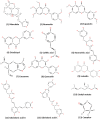Exploration of Lamiaceae in Cardio Vascular Diseases and Functional Foods: Medicine as Food and Food as Medicine
- PMID: 35774598
- PMCID: PMC9237463
- DOI: 10.3389/fphar.2022.894814
Exploration of Lamiaceae in Cardio Vascular Diseases and Functional Foods: Medicine as Food and Food as Medicine
Abstract
In the current scenario, cardiovascular disease (CVD) is one of the most life-threatening diseases that has caused high mortality worldwide. Several scientists, researchers, and doctors are now resorting to medicinal plants and their metabolites for the treatment of different diseases, including CVD. The present review focuses on one such family of medicinal plants, called Lamiaceae, which has relieving and preventive action on CVD. Lamiaceae has a cosmopolitan distribution and has great importance in the traditional system of medicine. Lamiaceae members exhibit a wide range of activities like antioxidant, antihyperlipidemic, vasorelaxant, and thrombolytic effect, both in vitro and in vivo-these are mechanisms that contribute to different aspects of CVD including stroke, heart attack, and others. These plants harbour an array of bioactive compounds like phenolic acids, flavonoids, alkaloids, and other phytochemicals responsible for these actions. The review also highlights that these plants are a rich source of essential nutrients and minerals like omega-3 and hence, can serve as essential sources of functional foods-this can have an additional role in the prevention of CVDs. However, limitations still exist, and extensive research needs to be conducted on the Lamiaceae family in the quest to develop new and effective plant-based drugs and functional foods that can be used to treat and prevent cardiovascular diseases worldwide.
Keywords: CVD; Lamiaceae; ethnopharmacology; functional food; medicine.
Copyright © 2022 Chakrabartty, Mohanta, Nongbet, Mohanta, Mahanta, Das, Saravanan and Sharma.
Conflict of interest statement
The authors declare that the research was conducted in the absence of any commercial or financial relationships that could be construed as a potential conflict of interest.
Figures





Similar articles
-
A Review on the Potential Use of Medicinal Plants From Asteraceae and Lamiaceae Plant Family in Cardiovascular Diseases.Front Pharmacol. 2020 Jun 5;11:852. doi: 10.3389/fphar.2020.00852. eCollection 2020. Front Pharmacol. 2020. PMID: 32581807 Free PMC article. Review.
-
Lamiaceae in the treatment of cardiovascular diseases.Front Biosci (Landmark Ed). 2021 Jan 1;26(4):612-643. doi: 10.2741/4909. Front Biosci (Landmark Ed). 2021. PMID: 33049685 Review.
-
Ethnomedicinal use, phytochemistry, pharmacology, and food benefits of Thymus capitatus.J Ethnopharmacol. 2020 Sep 15;259:112925. doi: 10.1016/j.jep.2020.112925. Epub 2020 May 11. J Ethnopharmacol. 2020. PMID: 32423878 Review.
-
Therapeutic importance of Cucurbitaceae: A medicinally important family.J Ethnopharmacol. 2022 Jan 10;282:114599. doi: 10.1016/j.jep.2021.114599. Epub 2021 Sep 4. J Ethnopharmacol. 2022. PMID: 34487849 Review.
-
The genus Nepeta: Traditional uses, phytochemicals and pharmacological properties.J Ethnopharmacol. 2021 Mar 25;268:113679. doi: 10.1016/j.jep.2020.113679. Epub 2020 Dec 8. J Ethnopharmacol. 2021. PMID: 33307050 Review.
Cited by
-
How climate change-related abiotic factors affect the production of industrial valuable compounds in Lamiaceae plant species: a review.Front Plant Sci. 2024 Jul 10;15:1370810. doi: 10.3389/fpls.2024.1370810. eCollection 2024. Front Plant Sci. 2024. PMID: 39049861 Free PMC article. Review.
-
Exploring the phytoconstituents, antimicrobial potency, and cytotoxic effects of essential oil from Origanum punonense from Palestine.BMC Complement Med Ther. 2024 Feb 28;24(1):106. doi: 10.1186/s12906-024-04395-4. BMC Complement Med Ther. 2024. PMID: 38418969 Free PMC article.
-
New Biological and Chemical Evidences of Two Lamiaceae Species (Thymbra capitata and Thymus sipyleus subsp. rosulans): In Vitro, In Silico and Ex Vivo Approaches.Molecules. 2022 Dec 18;27(24):9029. doi: 10.3390/molecules27249029. Molecules. 2022. PMID: 36558163 Free PMC article.
-
Potential use of the Asteraceae family as a cure for diabetes: A review of ethnopharmacology to modern day drug and nutraceuticals developments.Front Pharmacol. 2023 Aug 3;14:1153600. doi: 10.3389/fphar.2023.1153600. eCollection 2023. Front Pharmacol. 2023. PMID: 37608892 Free PMC article. Review.
-
Essential oil composition, morphological characterization, phenolic content and antioxidant activity of Iranian populations of Hymenocrater longiflorus Benth. (Lamiaceae).Sci Rep. 2024 Mar 27;14(1):7239. doi: 10.1038/s41598-024-57826-0. Sci Rep. 2024. PMID: 38538705 Free PMC article.
References
-
- Akinpelu B. A., Apata J. T., Iwalewa E. O., Oyedapo O. O. (2016). Evaluation of Anti-hyperlipidemic Potential of Ethanolic Leaf Extract of Clerodendrum Volubile P. Beauv. Ife J. Sci. 18, 789–800.
Publication types
LinkOut - more resources
Full Text Sources

